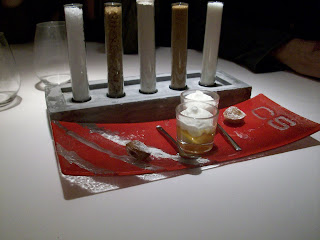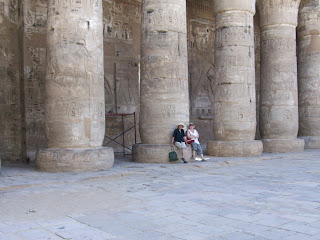
The next day the rain in Spain fell mainly in Barcelona. Despite the weather, we wandered under our umbrellas up the famous Rambla, a wide boulevard with a centre median made for strolling. There we saw the most creative buskers ever, people artfully made up and costumed to look like statues.(photo)
 They posed immobile for several minutes, then would move suddenly, bringing smiles and hopefully a few coins from passers by.
They posed immobile for several minutes, then would move suddenly, bringing smiles and hopefully a few coins from passers by.We also explored the old quarter of the city. Barcelona has existed since 230 BC, but enjoyed little prosperity until Charlemagne granted it independence in the ninth century. The first count,
 Wilfred the Hairy, (yes, really) consolidated the territory and began the House of Barcelona, which was to last for 500 Years. This ancient part of the city dates back to the middle ages, and its winding narrow streets are now packed with charming restaurants and wonderful old stone buildings.
Wilfred the Hairy, (yes, really) consolidated the territory and began the House of Barcelona, which was to last for 500 Years. This ancient part of the city dates back to the middle ages, and its winding narrow streets are now packed with charming restaurants and wonderful old stone buildings. 
Our apartment is in a more recent part of the city, Eixample. This area was built in the 1860-1910 era, the streets forming a grid system of wide boulevards lined with housing blocks of 3-5 stories. At each intersection there is a diamond-shaped widening of the street, which is replicated in the shape of the buildings. These chamfered intersections provide an airy, spacious feeling to the streetscape. They also provide the space and perspective to enjoy the design of the buildings across the intersection. Many of the buildings in this area are built in the style of the Moderniste movement,
 Barcelona's version of art nouveau. The Gaudi apartment buildings are here, but he is merely the best-known of many talented Moderniste architects such as Luis Domenech i Montaner and Josep Puig i Cadafalch.
Barcelona's version of art nouveau. The Gaudi apartment buildings are here, but he is merely the best-known of many talented Moderniste architects such as Luis Domenech i Montaner and Josep Puig i Cadafalch.The beautiful architechture makes the city a wonderful place to walk, a sort of outdoor art gallery. We walked everywhere, as our apartment was only six blocks from the Rambla.
It is also a wonderful place to eat, and we ate tapas several times, most notably at a place called Tapas 24. This restaurant offered delicious tapas including the McFoie Burger, that Alan and Kerry are seen holding,
 a burger made with foie gras, and patatas bravas, french fries with garlic mayonnaise and salsa brava (thick, spicy tomato sauce entirely unlike ketchup). Dessert was a dollop of dense chocolate mousse served with a dash of olive oil and kosher salt.
a burger made with foie gras, and patatas bravas, french fries with garlic mayonnaise and salsa brava (thick, spicy tomato sauce entirely unlike ketchup). Dessert was a dollop of dense chocolate mousse served with a dash of olive oil and kosher salt.Staying in an apartment meant that we had to shop, which gave us an excuse to go to Barcelona's fabulous markets. The Market
 St. Josep is right downtown, just off the Rambla. It is an old covered market with iron gates, and cast iron pillars supporting the vast high roof. It is the size of a city block. Every kind of food that is locally available can be found here, fruits, nuts, olives, vegetables, meats, fish and seafood, and baked goods of all kinds. Iberian hams and chorizo sausage, and many cheeses including several versions of the famous Manchego, were on sale. As may be expected, the market was always crowded, both with tourists taking photos and Barcelonans buying dinner.
St. Josep is right downtown, just off the Rambla. It is an old covered market with iron gates, and cast iron pillars supporting the vast high roof. It is the size of a city block. Every kind of food that is locally available can be found here, fruits, nuts, olives, vegetables, meats, fish and seafood, and baked goods of all kinds. Iberian hams and chorizo sausage, and many cheeses including several versions of the famous Manchego, were on sale. As may be expected, the market was always crowded, both with tourists taking photos and Barcelonans buying dinner.We cooked several memorable dinners in our apartment, all four of us making our own versions of tapas dishes. We bought a whole chicken one night, the neck and feet then went into a stock that in turn made a wonderfuil roasted tomato and garlic soup, which we ate with a tapas of breaded artichokes, fresh sardines, roasted asparagus, patatas bravas and dates stuffed with blue cheese and roasted almonds. The next night we roasted the chicken, and ate it with a delicious mushroom risotto and deep fried eggplant, lightly breaded and drizzled with honey.
Many of our daily iteineraries were planned around a chosen lunch destination, carefully selected by our friend Alan. One of these, Quimet i Quimet, is reputed to be the favourite haunt of a well-knowm Barcelona chef, and was recommended by two guide books. We arrived there after a long walk in Montjuic Park. We had passed up the Miro museum, due to an overlong line-up, and were looking forward to sitting down to an enjoyable lunch. Quimet i Quimet turned out to be a hole in the wall, with no chairs, so we stood to eat. We shared two plates of tapas, and had two glasses of wine and two beers among the four of us, for a bill of 49 Euros ($80 Cdn)! So much for the guide books.
We will definitely come back to this fabulous city. We were sorry to leave, but reluctantly climbed into our rented Seat Leon (it's a car) to drive to our next destination, a villa in a rural village in Languedoc





































